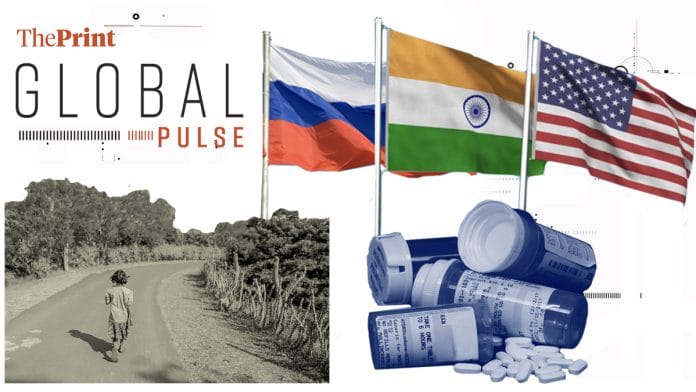New Delhi: A Mumbai-based pharmaceutical company, Aveo Pharmaceuticals, is reportedly manufacturing and illegally exporting unlicensed, highly addictive opioids to West Africa, where they are fuelling a public health crisis in countries including Ghana, Nigeria and Cote D’Ivoire.
According to a BBC Eye investigative report, Aveo makes a range of pills that are packaged to look legitimate, but all contain a harmful mix of ingredients, including a muscle relaxant so powerful that it’s banned in Europe.
“This combination of drugs is not licensed for use anywhere in the world and can cause breathing difficulties and seizures. An overdose can kill,” reports the BBC. “Despite the risks, these opioids are popular as street drugs in many West African countries, because they are so cheap and widely available.”
The BBC conducted a sting operation in Aveo, with an operative posing as an African businessman looking to supply opioids to Nigeria in conversation with Vinod Sharma, one of Aveo’s directors.
“In the secretly recorded footage, the operative tells Sharma that his plan is to sell the pills to teenagers in Nigeria ‘who all love this product’. Sharma doesn’t flinch. ‘OK,’ he replies, before explaining that if users take two or three pills at once, they can ‘relax’ and agrees they can get ‘high’. Towards the end of the meeting, Sharma says: ‘This is very harmful for the health’, adding ‘nowadays, this is business’,” reads the report.
“It is a business that is damaging the health and destroying the potential of millions of young people across West Africa.”
Aveo’s pills are causing misery across the streets of West Africa, with thousands of young people addicted to the pills. Publicly available export data shows that Aveo and its sister company Westfin International are shipping millions of such tablets to Ghana and other West African countries.
“Aveo is not the only Indian company making and exporting unlicensed opioids. Publicly available export data suggest other pharma companies manufacture similar products, and drugs with different branding are widely available across West Africa,” reports the BBC.
“These manufacturers are damaging the reputation of India’s fast-growing pharmaceutical industry, which makes high-quality generic medicines upon which millions of people worldwide depend and manufactures vaccines which have saved millions of lives. The industry’s exports are worth at least $28bn (£22bn) a year.”
The Economist writes about the face-off between the US and Russia at Aero India, one of Asia’s biggest air and defence shows, held last week in Bangalore. Military officials and arms makers gathered there to “mostly to tout their wares to India, which is the world’s biggest arms importer and is steadily diversifying away from Russia as its main supplier”.
But this year, The Economist writes, the commercial and geopolitical stakes were especially high given the war in Ukraine, Trump’s return to power and the anticipated Indian order for 114 fighter jets worth $20 billion.
“The Russian and American delegations carefully avoided direct contact, but in conversations with The Economist they readily badmouthed each other’s wares,” the report says.
“Although India has lately bought more American arms, including helicopters, transport planes and drones, it has resisted buying American fighters, which would bind it into a complex technological ecosystem for decades. India’s most recent fighter order was for 36 French Rafales in 2016; its other fighters are mostly of Russian origin,” it adds.
India has some hard choices to make, The Economist writes. “Brace for some diplomatic aerobatics in the months ahead.”
Another article in The Economist reports on India’s other little-known infrastructure revolution—its rural roads network.
“Since the turn of the century, and especially in the past decade under Narendra Modi, the prime minister, India has rapidly expanded its road connectivity,” the report says. “The national-highway network nearly tripled in length from 52,000 km in 2000 to over 146,000 km last year, adding an average of around 3,900 km a year.”
But what’s lesser known is the infrastructure revolution in the villages—in 25 years, India has added an additional 7.7 lakh km in rural roads.
“That effort to link villages to market towns with all-weather roads, known as the Prime Minister’s Rural Roads Programme (PMGSY, the Hindi acronym), was announced in 2000. It is part of an effort to narrow the huge urban-rural income gap and has been supported by every government since. Some states also run a complementary chief minister’s programme (MMGSY). Today the orange-and-black signboard marking a road built under the scheme is a familiar sight across India,” The Economist writes.
The result—reduced travel times, increased access to transport services, greater labour mobility out of agriculture, children staying in school longer, a slight rise in consumption and improved conditions for women.
Of course, “there remain many ills that roads alone cannot solve,” The Economist concedes. “Women did not report increased bank account ownership or property rights. Infant mortality increased, suggesting that better maternal care only delayed rather than averted some deaths. Most glaringly, there is no evidence that the roads raised rural income levels.”
But the full impact on income may not yet be apparent. Besides, simply investing in road infrastructure isn’t enough to fully develop villages. Agriculture, for example, is still afflicted by lots of bad policies which can’t be fixed simply by a paved road.
“Indeed, corruption at the local level is endemic across India. Some roads are built with dodgy materials or mixes. Local politicians may prioritise funds for areas where they have more voters,” the story reminds its readers. “But rural India has changed for the better thanks to the programme.”






